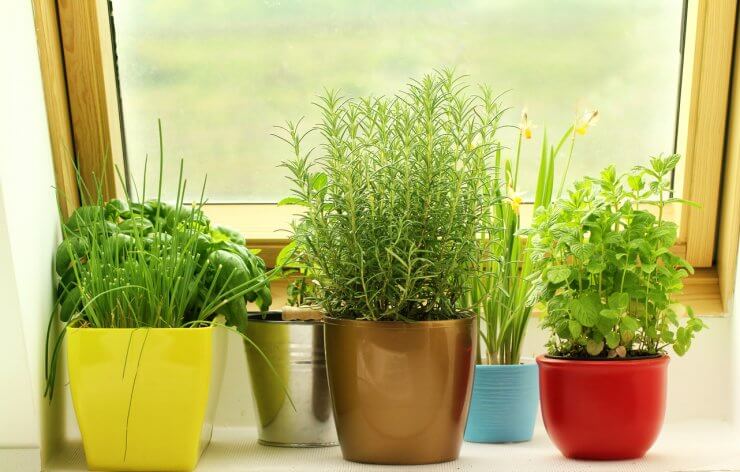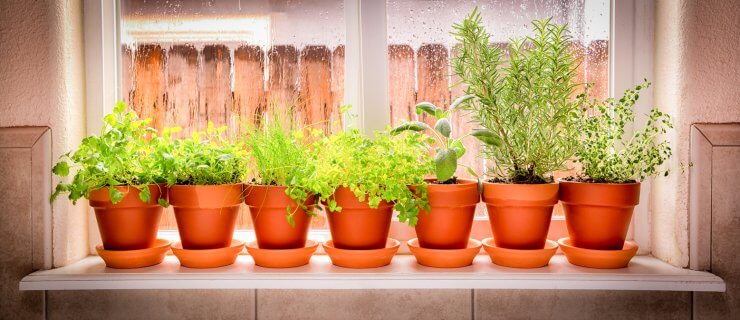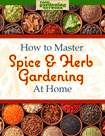
I love to cook, and I absolutely adore using fresh herbs in pretty much every dish. They’re easy enough to get in the summer, but since I live in New England, it’s a bit challenging to step out to the garden in mid-winter for a sprig of fresh rosemary or a few basil leaves. The solution? A countertop herb garden.
Admittedly, it took me a few tries before I had much success with growing herbs indoors. Getting them started isn’t so bad, but with limited sunlight and cool temperatures, it’s hard to keep them growing and healthy. The fact is, most herbs really don’t like that icy draft by the windows. Fair enough. I don’t care for it myself. But on the countertop, away from the windows, there’s even less of that minimal winter sunlight those herbs so desperately crave.
What’s nice, however, is that if you can grow a vivacious countertop herb garden in the winter, it’s a breeze to keep one going in the summer, too. Yes, it’s a bit easier than running out to the garden to grab what you need. But the real prize is that wonderful aroma that makes your kitchen smell like heaven all day every day. So there are a lot of reasons to grow some herbs indoors.
Find out how easy growing spices and herbs can be—indoors or out! Read our FREEBIE How to Master Spice and Herb Gardening at Home right now!

Your 5-step guide to a successful countertop herb garden
Herbs are fairly easy to start either from seeds or from cuttings. But if you want the joy and excitement of starting your countertop herb garden from scratch, go with seeds. It’s by far the most affordable option – you can get a packet of hundreds of seeds for a few bucks. Plus, it’s just really cool to watch nature happen like that. Here’s how to get them started.
1. For most herb seeds, soak them in water overnight. This helps soften the outer shell and makes it easier for them to germinate.
2. Plant them in a small container that you can keep warm. I’m a huge fan of paper egg cartons because then I don’t have to buy any more containers. Plus I can either plant them right in the ground if that’s what my plan is. Or in the case of a countertop herb garden, they’re easy enough to tear open and put in the compost. Be sure to use a high-quality potting mix so your seedlings can get plenty of the nutrients they need to help them grow.
3. Group your seeds so all the seedlings in a container emerge at approximately the same time. Sage, for example, will need 14-21 days to emerge, whereas basil only needs 7-14 days. Why is this important? As soon as your seedlings emerge, they’ll need a lot of light, so you will likely need to move them (more on that in a moment).
Find out how easy growing spices and herbs can be—indoors or out! Read our FREEBIE How to Master Spice and Herb Gardening at Home right now!
4. Keep the soil moist and warm. Before the seedlings emerge, warmth and moisture is more important than light. If you keep your home toasty, you may be able to start them in the same place they will eventually live. I like to start mine on top of the refrigerator, since heat rises and the refrigerator is the highest “elevation” in my home, plus there is a bit of warm air that comes from the back of the fridge.
5. Give them plenty of light. Once your seedlings emerge, they need light, and lots of it. Honestly, unless it’s summer or you live pretty far south, your best chance of success here is to use a grow light. There are a variety available, some of which come as complete kits, while some look more like a traditional desk lamp. The secret here is to get one with an easily adjustable height. You want to keep the light close to the herbs so they grow bushy rather than leggy. (If the light is too far away, they’ll “stretch” to reach it, giving you more height, but fewer of those yummy leaves.)
That’s really the bulk of it. Of course, the usual gardening rules apply: Keep your plants watered but not soaked, make sure the soil has good drainage, and don’t crowd your plants into one container.
One last helpful tip I might add is that you may have better luck using varieties that are bred specifically for containers. Urban Leaf specializes in varieties that do well indoors, and Burpee has a section of “Container Herb” seeds.
So go. Plant those seeds! Enjoy yourself some fresh herbs all year long, no matter what season it is.
How has your experience been with growing herbs indoors? Any tips you would add? I’d love to read your ideas in the comments.
Find out how easy growing spices and herbs can be—indoors or out! Read our FREEBIE How to Master Spice and Herb Gardening at Home right now!




